What is Software Prototyping And Its Types? – TatvaSoft Blog

In a world where a software solution is very important for any business, the owners of organizations try to find a perfect software development service provider for their firms. And the group of developers who believe in offering a robust and unique solution to their clients follows a method that includes creating software prototypes before actually starting the development process. To learn more about software prototyping, why it is required, its working model, process, and pros & cons, let’s go through this blog.
Mục lục bài viết
1. What Is Software Prototyping?
A software prototype is a simulation of how the actual project will look, work, and feel and would not have an exact logic involved in the software development phase. Software development team members use it for designing user feedback and user testing. And they come in various levels of sophistication. Software prototyping refers to the process that starts by creating an idea, sketching it, and making it into a clickable prototype that mimics real software.
The prototype can offer simulation for the entire software or mobile application as per the requirement of the user. Basically, prototyping in software development is just like a scale building model that is utilized in designing architecture. In that case, creating a sophisticated prototype is necessary as it enables making a complex project look easy. It enables the customers to see the exact plan of the software development and by having a look at that, they can provide feedback to the software designer.
The best part of a software prototype is that it is cheaper and easier as changes can be made in the middle of the software development process instead of making changes after its completion. Therefore, while creating software, an engineer prefers to develop an initial prototype that he/she can use to gather feedback from the project owner.
2. Why Do You Need A Software Prototype?
When it comes to creating software for the client from the very beginning, the process starts from the initial planning phase. The software development team comes with an application idea that is very well thought out so that the implementation can be easy. The team follows the software development life cycle (SDLC) process to have a clear and straightforward approach among the team members.
This process starts with developers gathering all the software-related information from the client and understanding the client’s requirements. The next step is to start the designing process. It offers details of what the software’s end-user interface will look like. After that comes the actual coding part of the system. It is the most lengthy part of the software development life cycle. Later, the team checks the code and fixes the bugs if there are any. And the final step to do is to launch it. And in this entire process, prototyping software can help by cutting down the overhead costs.
Basically, software prototypes help software developers to visualize the final product before the software development company starts investing resources into it. It is not an exact replica of the software but it is a quick mock-up that offers a rough idea about the system’s functioning and appearance to the software engineering team. The team can see the prototype and can decide whether the idea of this project is worth the investment or not. Besides this, as prototypes offer a clear idea about the system, the end result can be as user-friendly as possible.
3. Types of Prototyping Models
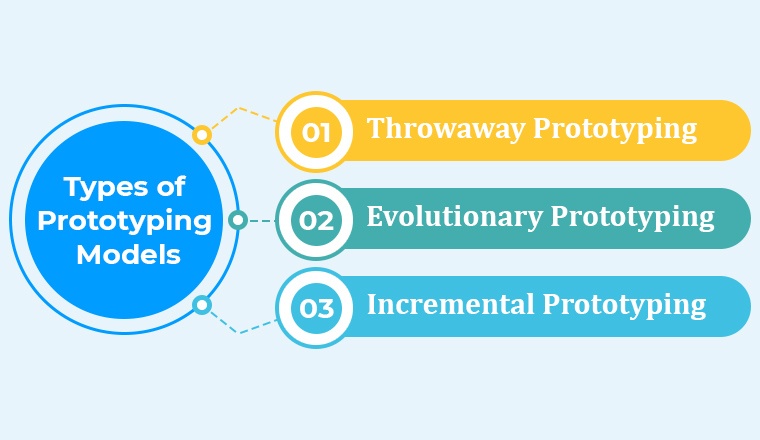
Here are some of the top types of prototyping models –
3.1 Throwaway Prototyping
Rapid throwaway or rapid prototyping is one the most important type of prototyping models. It is based on the preliminary requirement of the software applications. The throwaway prototype can be quickly developed by the team to show how the initial requirements of the system will look visually. In this model, the feedback from the customers helps in driving changes in the requirements and after the user feedback is received, the prototype is again created to meet the client’s needs.
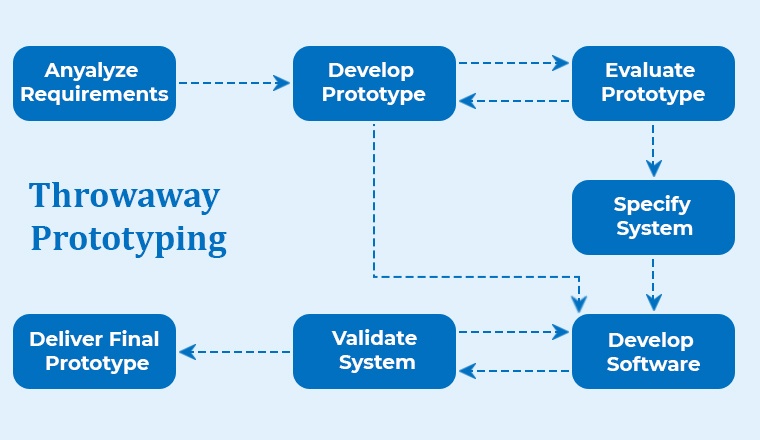
Basically, in this approach, the prototype created by the team will be discarded and won’t become a part of the final accepted prototype. This model is used by the software product designing team to explore ideas and get instant feedback from the clients.
3.2 Evolutionary Prototyping
Another type of prototyping is an evolutionary prototype. Evolutionary prototypes are created by the team in an incrementally refined manner after accepting the customer’s final feedback. This type of prototyping enables the team to save a lot of development time and effort. And the main reason behind it is that the development of a prototype from scratch for every different interaction can be very frustrating.
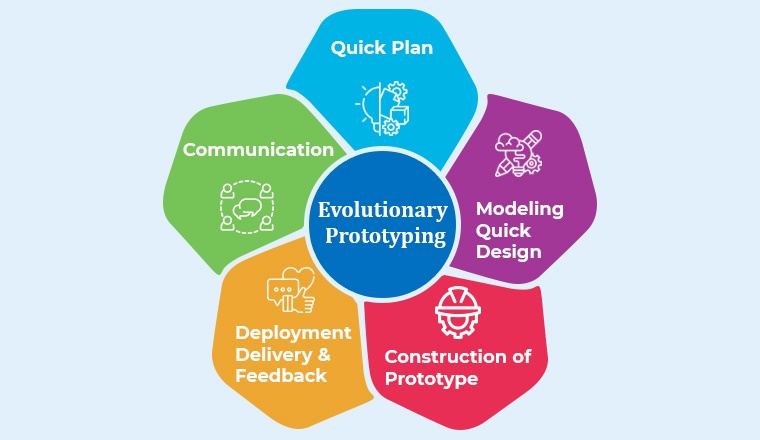
The design team works on prototypes like this when the technology that is going to be used in the project is new and not well understood by the team. It is also the perfect model when it comes to working on a complex project where all the features must be checked at least once. Basically, evolutionary prototyping in software development is useful when the software requirement is not understood perfectly or it is not stable at the initial stage. Besides, the screens (user interface) also have actual code behind them. The user can see and interact with the prototype as if it were the actual product. Over time and multiple feedback cycles, the prototype may have more advanced functionality added to it as needed by the client. The process thus results in the finished product.
3.3 Incremental Prototyping
Incremental is a type of prototyping that enables the division of the final product into smaller prototypes and then they are developed individually. This means that different prototypes can be merged into a single software. This approach is used to reduce the feedback time between the application development team and the user.
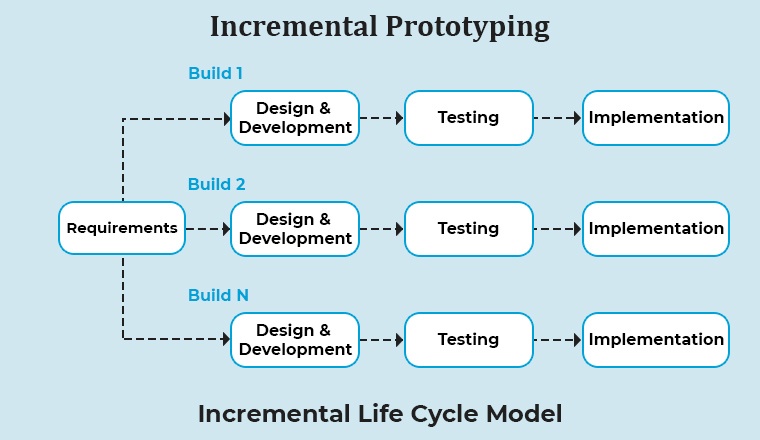
3.4 Other Types
Besides the above-listed prototypes, there are some other software prototyping techniques. They are of different types as per the level of software details one wants to see in the prototype. And when a very basic or low-effort prototype is created, it is called a low-fidelity prototype. The best example of this is a paper prototype. The designing team can also create a prototype in a detailed form, and it is known as a high-fidelity prototype. Basically, creating a prototype depends on the software requirements, the software developers or designers, and how the experts use the client’s user interface design and software prototyping tools to represent the system.
4. Factors That Decide The Best Type Of Prototyping For You
As seen above, there are different types of software prototyping available in the market. And this list makes it difficult for the team members to make the decision of choosing the perfect software prototyping technique. The final choice depends on the following factors:
- Software Prototyping Time
- Cost of Software Prototypes
- Scope & Fidelity of Building Prototypes
5. The Prototyping Process
Here are the steps that every software developer must follow while going through the prototyping process.
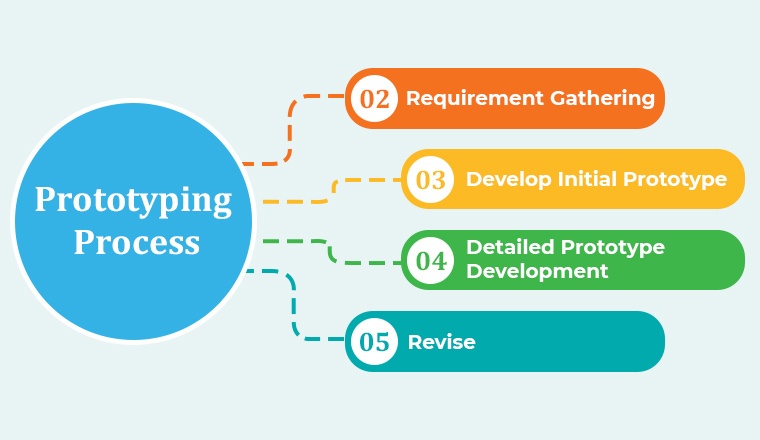
5.1 Requirement Gathering
When it comes to the prototyping process, the very first step is to identify the problem of the software and come up with a complete version of the software solution. In this, the developing team must be very clear about what activities the application will be used on the platform. And for this, the developers must ask the project owner for extensive details about the features and functionalities. And here the owner can give his ideas regarding the potential software design. After understanding the project’s type and its requirements, the developers can create the prototype.
Before starting the creation of the prototype, the developer must see to it that he has all the required details. As well as per the requirement analysis, he can specify all the software details in the prototype.
5.2 Develop Initial Prototype
The earliest prototypes are created by focusing on the general arrangement of the appearance of the software application. Besides this, the client also describes the functionality of the system in the initial stage by the client. It can be in the form of on-paper wireframes which is low-fidelity prototypes. Here the outline of the application is informally outlined and a few basic functions will also be highlighted.
5.3 Detailed Prototype Development
If the developers feel like they need to create a more detailed functional prototype of the software for their own use and for the client’s review, they can develop a detailed version of the software design and coding. This can help us to understand the business processes by the design and development team. And for this, they can use advanced design and software prototyping tools to develop a comprehensive architecture.
5.4 Revise
The last step in the software prototyping process is to make revisions to the prototypes created after taking the client’s feedback & requirements into consideration.
6. Advantages Of Software Prototyping
Some of the major advantages of prototyping software applications are –
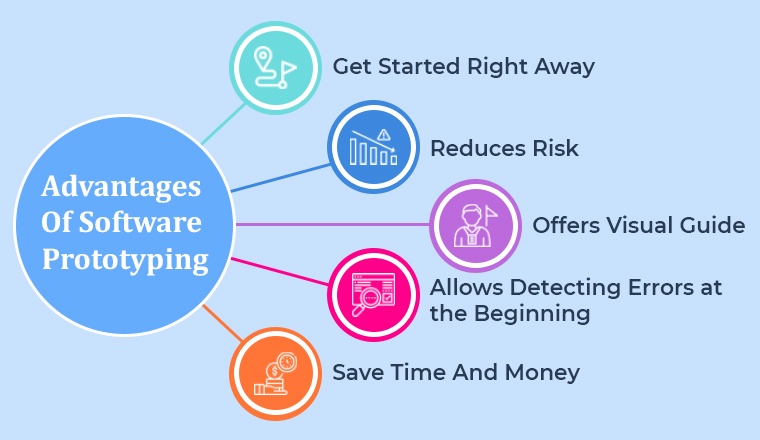
6.1 Get Started Right Away
Developing a software application is not always an easy task, it can be quite daunting especially when the software is complex and the team has to think about every single thing the client requires. In the beginning, the engineers can share a few ideas with the client and after the approval, the designers can get start working by creating a rough that can be refined later if required.
6.2 Reduces Risk
One of the most important benefits of software prototyping is reducing risks. If the developer wants to avoid the scenario from the start and reduce the risk of software failure, he must implement software prototyping. This concept enables the developers to offer the perfect solution as per the client’s feedback.
6.3 Offers Visual Guide
Software prototyping comes with the best feature known as a visual guide. It enables the developers to see quick results. The best part about it is that the clients can also get an easy-looking overview of the system that the hired team has designed.
The basic prototype of the system enables both the clients and developers to get the perfect idea of the system. While the high-fidelity prototype is an approach that enables one to see what exactly the software solution will look like after it will be developed. A high-fidelity prototype allows one to have an interaction with it by going through different screens, making sure the application flows smoothly & perfectly, and clicking up buttons.
6.4 Allows Detecting Errors at the Beginning
With the help of software prototyping, developers understand the issues in the system very easily. They can detect errors in the product concept. And because of the early detection, problematic issues can be solved efficiently and quickly. This means that errors cannot disrupt the development process as the errors are detected and eliminated from the actual product. It also enables in reducing the cost and time of implementing changes.
6.5 Save Time And Money
When new software is implemented in any organization, learning and understanding it and its functionalities can be difficult for the employees. Even when the employees start learning more about the system, it is not necessary that the team will be happy with it. The company should hire a development company that creates prototypes and takes feedback on them before starting to work. Through this, the business owner can give feedback and make the system develop as per the requirements.
This means that prototyping is one of the best things to do if one wants to identify problems early. This is beneficial for both developers and business owners. It helps in saving a lot of time and money.
6.6 Improves Client’s Involvement
Software prototyping also has the capability to enable the customers to take part in developing the system. And this can be beneficial for both development team members and clients. The reason behind it is that it enables the clients to share their critiques and opinions. While it allows the development team to be fully aware of customers’ needs.
7. Disadvantages Of Software Prototyping
Some of the disadvantages of software prototyping are –
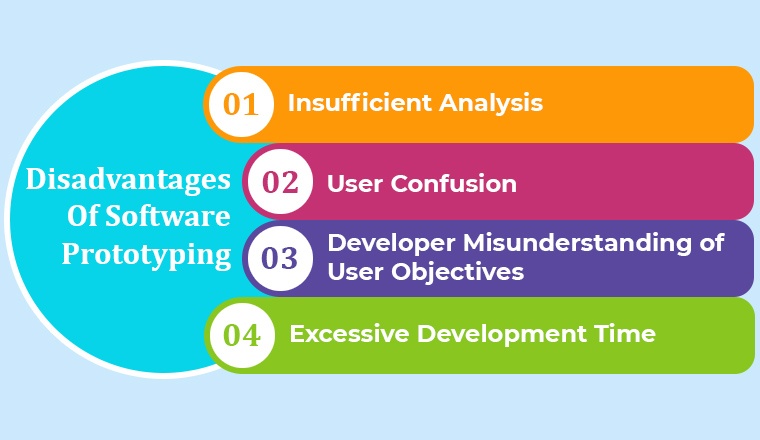
7.1 Insufficient Analysis
When a developer only limits his focus on the prototype, it can distract him from analyzing the entire project. One can overlook the better solutions, conversion of limited prototypes, and incomplete specifications.
7.2 User Confusion
Some of the clients feel that the prototype is a finished project. They see the rough version of the system and feel that this is it, the final software product is just a polish away. And this also makes the clients wrongly perceive the prototype to be an accurate model.
7.3 Developer Misunderstanding of User Objectives
For every software development project to be successful, both customers and developers have to be on the same page. This means that when clients give a list of all required features and the clients show that in the prototype, it can create a conflict in the team. The main reason behind it is that all the suggested features might now be perfect for the software.
7.4 Excessive Development Time
Prototypes are something that is created so that the development process can be followed quickly. If the developer spends a lot of time designing a complex prototype, the project can run late and this can also cost a lot of money.
8. Conclusion
As seen in this blog, prototyping is a much easier and simpler approach in the world of software development. It is something that can bring both the users and the developers on the same page and this can help in saving a lot of last-minute hassles. This also helps in translating to a significant financial advantage with no wastage of development time. Basically, if the software prototype is great, it means that the entire system will be perfect with minimal difficulties.











